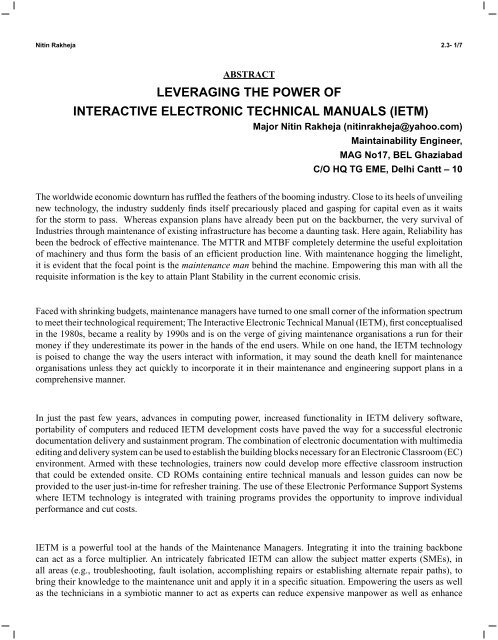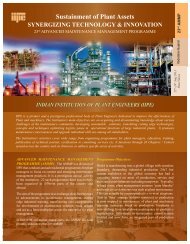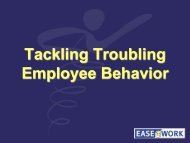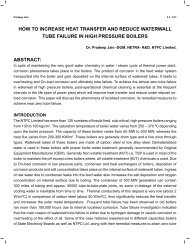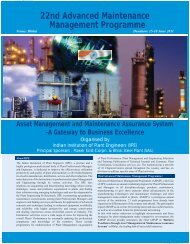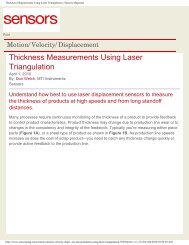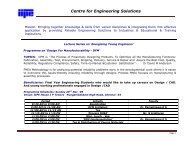Download - IIPE
Download - IIPE
Download - IIPE
Create successful ePaper yourself
Turn your PDF publications into a flip-book with our unique Google optimized e-Paper software.
Nitin Rakheja 2.3- 1/7<br />
ABSTRACT<br />
LEVERAGING THE POWER OF<br />
INTERACTIVE ELECTRONIC TECHNICAL MANUALS (IETM)<br />
Major Nitin Rakheja (nitinrakheja@yahoo.com)<br />
Maintainability Engineer,<br />
MAG No17, BEL Ghaziabad<br />
C/O HQ TG EME, Delhi Cantt – 10<br />
The worldwide economic downturn has ruffled the feathers of the booming industry. Close to its heels of unveiling<br />
new technology, the industry suddenly finds itself precariously placed and gasping for capital even as it waits<br />
for the storm to pass. Whereas expansion plans have already been put on the backburner, the very survival of<br />
Industries through maintenance of existing infrastructure has become a daunting task. Here again, Reliability has<br />
been the bedrock of effective maintenance. The MTTR and MTBF completely determine the useful exploitation<br />
of machinery and thus form the basis of an efficient production line. With maintenance hogging the limelight,<br />
it is evident that the focal point is the maintenance man behind the machine. Empowering this man with all the<br />
requisite information is the key to attain Plant Stability in the current economic crisis.<br />
Faced with shrinking budgets, maintenance managers have turned to one small corner of the information spectrum<br />
to meet their technological requirement; The Interactive Electronic Technical Manual (IETM), first conceptualised<br />
in the 1980s, became a reality by 1990s and is on the verge of giving maintenance organisations a run for their<br />
money if they underestimate its power in the hands of the end users. While on one hand, the IETM technology<br />
is poised to change the way the users interact with information, it may sound the death knell for maintenance<br />
organisations unless they act quickly to incorporate it in their maintenance and engineering support plans in a<br />
comprehensive manner.<br />
In just the past few years, advances in computing power, increased functionality in IETM delivery software,<br />
portability of computers and reduced IETM development costs have paved the way for a successful electronic<br />
documentation delivery and sustainment program. The combination of electronic documentation with multimedia<br />
editing and delivery system can be used to establish the building blocks necessary for an Electronic Classroom (EC)<br />
environment. Armed with these technologies, trainers now could develop more effective classroom instruction<br />
that could be extended onsite. CD ROMs containing entire technical manuals and lesson guides can now be<br />
provided to the user just-in-time for refresher training. The use of these Electronic Performance Support Systems<br />
where IETM technology is integrated with training programs provides the opportunity to improve individual<br />
performance and cut costs.<br />
IETM is a powerful tool at the hands of the Maintenance Managers. Integrating it into the training backbone<br />
can act as a force multiplier. An intricately fabricated IETM can allow the subject matter experts (SMEs), in<br />
all areas (e.g., troubleshooting, fault isolation, accomplishing repairs or establishing alternate repair paths), to<br />
bring their knowledge to the maintenance unit and apply it in a specific situation. Empowering the users as well<br />
as the technicians in a symbiotic manner to act as experts can reduce expensive manpower as well as enhance
Nitin Rakheja 2.3- 2/7<br />
operational fitness of the machinery thus providing a solid foundation in these shaky soils.<br />
Introduction<br />
Although cutting down maintenance expenditure may not have any immediate fallout, long term<br />
effects of such an approach towards cost cutting have proved to be disastrous. This notwithstanding,<br />
in Industry, one of the fi rst victims of a slowdown is the Maintenance Budget. Axing of maintenance<br />
expenses is rampant during economic downturns even when the long term consequences are visible.<br />
It thus becomes quite evident that to prevent the complete collapse of a plant, maintenance managers<br />
have to be innovative to survive and sustain during times of meltdown and yet continuously provide for<br />
the inescapable need of maintenance.<br />
One of the factors that can act as a limited panacea to the pruning of the maintenance budget is<br />
changing the mode of storing the Technical Support Data and Maintenance Information. Converting the<br />
paper based ‘Technical Manuals’ and ‘Literature’ into highly interactive ‘Electronic Books’ has revealed<br />
that there is a phenomenal potential available to improve the effi ciency of maintenance organisations.<br />
Industries have thus begun to realize the advantages of Electronic Technical Manuals over ‘Paper<br />
Books’ based technical support data.<br />
IETM<br />
An IETM or Interactive Electronic Technical Manual is an electronic medium to manage technical<br />
documentation. IETMs compress volumes of text into Data Discs or online pages which may include<br />
sound and video, and allow readers to locate needed information far more rapidly than in paper manuals.<br />
The results are; massive cost cutting in holding/updating/storing maintenance information, timely<br />
availability of accurate knowledge, reduced expensive trained manpower requirement, economising<br />
on space, accessibility of information from remote/cut off sites, much higher MTBF and much reduced<br />
MTTR, accurate fault diagnosis with faster repairs, portability of information eventually leading to a<br />
vastly reduced maintenance budget.<br />
Cutting Costs using IETMs<br />
The use of automated techniques to create, manage, deliver and update technical information<br />
documentation via an easily revisable database across hardware and software neutral platforms can<br />
greatly reduce the life-cycle costs of technical information and improve the quantity and functional<br />
integration of information for end-user use. The IETM and its associated database can act as the<br />
repository for all deliverable technical information relating to the documented system; information which<br />
can be extracted easily and quickly. The introduction of IETM solves or mitigates many of the problems<br />
with the Engineering Support Documentation in the form of Paper Books:
Nitin Rakheja 2.3- 3/7<br />
1) Weight – Where mobility is a top priority (ships, aircrafts, mobile ground units), every area where<br />
a reduction in weight can be accomplished is scrutinized. Standard calculations assume that a CD can<br />
store approximately 3,400 pages of text, tables and graphics.<br />
2) Volume – Paper takes up much needed space. The same documentation would occupy much<br />
less space if placed entirely on CD. Many facilities, which now receive duplicate copies of a single<br />
technical manual, operate in a networked environment. A single copy of an IETM on CD would be<br />
suffi cient for the initial IETM network installation and would serve as a backup.<br />
3) Information Access – At a minimum, even the most basic (Class I) IETMs provide a limited<br />
hyperlinking capability to allow the user to point, click, and quickly access desired information. The<br />
functionality of higher order classes permits word/phrase search capability, internal cross- reference<br />
links and links to other material (inventory, training, etc.). Northwest Airlines, using a prototype system,<br />
experienced a minimum 50% reduction in airline mechanics’ time spent looking for the appropriate<br />
documents.<br />
4) Up-to-date Information – Once an IETM has been developed, integrating and distributing updates<br />
can be a continuous process.<br />
5) Reduced fault isolation times - With complex systems, fault isolation is probably the most<br />
diffi cult step in any maintenance sequence. An IETM signifi cantly shortens the time required to perform<br />
troubleshooting with its interactive functions. A technician enters a test result and the IETM can<br />
automatically and immediately advance to the next appropriate test. This process continues until the<br />
cause of the problem is isolated. This results in<br />
a) Increased percentage of successful fault isolation<br />
b) Reduced maintenance time<br />
c) Reduced false alarms - This can be a serious matter in aircraft industry.<br />
d) Reductions in false removal rates<br />
e) Greater effectiveness of inexperienced technician<br />
f) Improved personnel and equipment safety<br />
g) Reduction in turn-around time for reporting and correcting technical manual discrepancies<br />
h) Reduction in technician time spent completing maintenance reporting forms<br />
Classes of IETMs<br />
The functionality of IETMs systems is divided into fi ve classes. These classes are more like broad<br />
guidelines with most real-world IETM products falling somewhere in between two classes.
Nitin Rakheja 2.3- 4/7<br />
• Class I - This IETM class follows the structure and format of a printed book, with indexes and<br />
table of contents that are hyperlinked into the content of the document. This might be a scanned book<br />
with some links added.<br />
• Class II - This format includes more hyperlinks than Class I, such as fi gures, tables and section<br />
references. A hyperlinked PDF document is the typical example. The document would be authored in<br />
XML/SGML.<br />
begin begin end Class 2 Class 3 Class 5 Class 4 • Page oriented • Redundant • Linear<br />
•<br />
Class III - The difference between Class II and Class III is analogous to the difference between PDF<br />
book and a web site. The book structure is discarded; instead the document is structured more freely<br />
following the logic of the content. The document can still be printed but it won’t necessarily match the<br />
presentation on the screen. Hyperlinking throughout the document is expected. The document would<br />
be authored in a markup language, typically SGML.<br />
• Class IV - This class stores the data in a relational database, obtaining benefi ts of data integrity<br />
and removal of data redundancy. Relationships in the content that are presented as hyperlinks, are<br />
mapped directly to relations in the database schema. Redundancy in the data that exists in earlier<br />
classes is removed. The sequence of presentation is also different than earlier classes. There is no<br />
longer the concept of a static page. Content can change dynamically based on users’ navigation and<br />
input through the content; the content may now be user specifi c. However, it is no longer possible to<br />
print a linear format of the document.
Nitin Rakheja 2.3- 5/7<br />
• Class V - In this class the documentation is integrated with expert systems that may infl uence<br />
the display of content. For example, the IETM system may aggregate data from a large number of<br />
user inputs; feed that to the expert system that analyzes it and then the result gets fed back to the user<br />
through the IETM system.<br />
Strategies for Implementation<br />
The Industry IETM Strategy should intend to identify, develop, and fund IETMs that contribute the<br />
greatest potential for cost saving effi ciencies while improving the functionality and readiness of the<br />
machinery and controlling systems in force in the Plant. IETMs would thus be customized solutions<br />
for every plant keeping in view the structure, expectations from maintaining sub-units, supply chain<br />
characteristics, reliance on partners, technology intensiveness in the plant, aptitude of workers, futuristic<br />
expansion vision and possible integration into the existing maintenance solution. The goal must be to<br />
establish a management structure and evaluation criteria that will accelerate IETM implementation to<br />
derive maximum benefi ts from:<br />
• Reduced system maintenance costs and time<br />
• Increased system availability<br />
• Reduced training costs and course lengths<br />
• Improved repair technician performance, quality, and effi ciency<br />
• Reduced costs to author, deliver, manage, and update TM information<br />
• Capability to transmit to remote locations.<br />
‘IETM integrated Training’ Strategy<br />
Today’s industry budgets must demand the cost effective development of IETM products that serve both<br />
maintenance and training requirements. IETMs are a key source of data to implement the electronic<br />
classroom and on-the-job training. Training benefi ts from IETMs have already been demonstrated<br />
through practical applications in several programs. Training development for a system is a long and<br />
complex logistics support process that is begun early in system acquisition. Clearly, there is a major<br />
interface between development of training and the development of IETMs. When appropriate, a training<br />
plan (or equivalent) should address those IETM items needed for familiarization, formal classroom, and<br />
on-the-job training for system operation, maintenance, and other special forms of logistic support. To<br />
identify and understand requirements and interfaces, close coordination between the maintenance<br />
planning, technical manual, and training disciplines for an IETM is required. In order to determine the<br />
IETM functionality needed to economically support training, input is required on training infrastructure<br />
requirements and its objectives to:
Nitin Rakheja 2.3- 6/7<br />
• Develop, reduce or eliminate formal course training<br />
• Develop on-site training<br />
• Defi ne and develop a shared IETM and training database<br />
Once the equipment and user training requirements are determined, all disciplines must identify the<br />
issues and resources required for each to implement the IETM within their community. The Training<br />
Plan is needed prior to contract award to permit defi nition of IETM features needed to support the<br />
training requirements, whether in a formal classroom or on-site.<br />
There are four strategies for approaching the interface between training and the IETM development<br />
process:<br />
• Coordinated (exchanging fi les, interfacing software) - Independent IETM and training<br />
product development with planned and coordinated exchange of IETM fi les, software, etc. for<br />
interface with automated curriculum development programs.<br />
• Concurrent (developing some shared data, sharing/interfacing software) - Simultaneous,<br />
planned, and coordinated development of IETM and training support products; development<br />
and use of shared data and software; initial joint planning and requirements determination<br />
which enable data integration into the training curriculum.<br />
• Integrated (developing a shared database; sharing software) - Structured, concurrent,<br />
and shared development of all maintenance, operations, and training materials into a single,<br />
fully integrated database that uses multiple tailored view packages to present material to various<br />
users.<br />
• Embedded - Combining all requirements and materials into an integrated database<br />
with a single view package so that training materials are indistinguishable from maintenance,<br />
operations, and other materials; enable operations, maintenance, and training personnel to use<br />
a single product.<br />
In its initial planning, it must be decided which approach will provide the most benefi t, including acquisition<br />
and support of both IETM and training requirements throughout the life-cycle. As training will have a<br />
signifi cant impact on both acquisition and life-cycle costs, these decisions may affect the choice of<br />
IETM that will most appropriately support the system.<br />
Conclusion<br />
In just the past few years, advances in computing power, increased functionality in IETM delivery
Nitin Rakheja 2.3- 7/7<br />
software, portability of computers and reduced IETM development costs have paved the way for a<br />
successful electronic documentation delivery and sustainment program. The combination of electronic<br />
documentation with multimedia editing and delivery system can be used to establish the building blocks<br />
necessary for an Electronic Classroom (EC) environment. Armed with these technologies, trainers can<br />
develop more effective classroom instruction that could be extended onsite. CD ROMs containing entire<br />
technical manuals and lesson guides can now be provided to the user just-in-time for refresher training.<br />
The use of these Electronic Performance Support Systems where IETM technology is integrated with<br />
training programs provides the opportunity to improve individual performance and cut costs.<br />
IETM is a powerful tool at the hands of the Maintenance Managers. Integrating it into the training<br />
backbone can act as a force multiplier. An intricately fabricated IETM can allow the subject matter<br />
experts (SMEs), in all areas (e.g., troubleshooting, fault isolation, accomplishing repairs or establishing<br />
alternate repair paths), to bring their knowledge to the maintenance unit and apply it in a specifi c<br />
situation. Empowering the users as well as the technicians in a symbiotic manner to act as experts can<br />
reduce expensive manpower as well as enhance operational fi tness of the machinery thus providing a<br />
solid foundation in these shaky soils.


